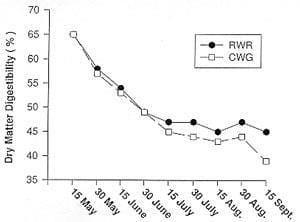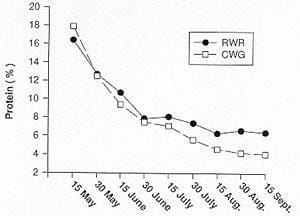Stand Establishment
Preparation
Establishing a pasture of Russian wildrye will require preplanning at least a year before seeding. The site should be selected with the following in mind:
- soil texture and fertility;
- topography;
- location of water; and
- grazing system to be applied, etc.
Perennial weeds must be controlled in advance of seeding. Straw and chaff should be spread or removed prior to seeding.
Date of seeding
Russian wildrye can be difficult to establish, due to its slow growth as a seedling. To overcome this characteristic, it is important to seed into firm, moist soil at a depth of 2.0-2.5 cm (3/4 to 1 inch). If the weather co-operates, the seedling roots will have sufficient time to grow down into more stable moisture conditions before the surface dries out. The weather is more likely to be favorable in spring, ie. April to early June, for establishment of the seedling. One alternative, if conditions are right, ie. prepared seed bed with good surface moisture, is to seed from August (after summer heat) up to mid-September. Seedlings need two to three leaves to survive the winter. The advantage of late summer seeding is that this pasture should be available for grazing by summer or fall of the following year, especially if sown with a fast-growing grass i.e. slender wheatgrass. Another alternative for producers is 'dormant' seeding. By seeding late in October, more time is usually available to devote to setting drills and preparing seedbeds. The disadvantage is that there is no control over weather conditions through winter and spring. The seed may germinate prematurely during a winter thaw and then winter-kill. Conditions may be dry in the spring.
Companion crop
If a companion crop is used, choose a less competitive annual, reduce the seeding rate, and use one-half the drill runs. Sow the forage crop after the annual at right angles to the companion crop. Some producers have modified drills to sow the annual and perennial in alternate rows (with suitable adjustments for seeding depth).
Row Spacing and Arrangement
Once established, Russian wildrye is very competitive with legumes and other grasses. Kilcher and Heinrichs (1971) used row spacing and row arrangement to address this characteristic. Row spacings up to 90 cm (3 feet) have been recommended but produce a rough field prone to erosion. (All Russian wildrye pastures are very 'rough'). Wider rows may result in more stems/less leaves (Jefferson and Kielly 1994). Weeds may invade the bare ground. However, wider row spacings will result in more forage in a dry year. Narrower spacings of 35 - 55 cm (14 to 20 inches) are a reasonable compromise for pasture and hay. This will depend on row arrangement and mixtures as well.
Competition between species can be changed by seeding in an alternate row or cross-seeding pattern. This is especially recommended for Russian wildrye-legume mixtures. Grazing management becomes more complex as grass or legume may be preferred or may predominate at any given season. If the legume is alfalfa, then bloat may be a hazard. However, separation is recommended to extend the productive life of the legume and the pasture.
Russian wildrye may be combined with other faster-growing grasses to hasten establishment. Dahurian wildrye or slender wheatgrass have been tried at Swift Current. It is recommended that the rapid-growing grass be sowed in alternate rows with the legume and across the Russian wildrye. Sweet clover may also be used in the mixture although yields and competition of sweet clover are difficult to predict.
Forage Production
Russian wildrye is less productive than most introduced forages. This may be related to the greater forage protein and its higher requirements for nitrogen than most grasses. In 25 years at Manyberries, Alberta, Russian wildrye produced 589 kg/ha (540 lb/ac) compared to 850 kg/ha (780 lb/ac) for crested wheatgrass and 403 kg/ha (370 lb/ac) of short grass native range (Smoliak and Dormaar 1985). At Swift Current, Lawrence and Heinrichs (1968) reported yields of 654 kg/ha (600 lb/ac) for Russian wildrye over a 15 year period. These yields are increased substantially by growing Russian wildrye and alfalfa together. In the Swift Current test, Russian wildrye-alfalfa produced 1036 kg/ha (950 lb/ac). During a test period of nine years, Kilcher (1980) found Russian wildrye-alfalfa yields of 1614 kg/ha (1480 lb/ac). In general, forage yields are related to spring soil moisture (1 April) and April to August precipitation, fertility and age of stand.
Carrying Capacity of Russian Wildrye Pasture
If pastures are grazed to a constant carry-over, carrying capacity will reflect annual forage production. Annual carrying capacity is as variable as weather factors: precipitation, temperature and wind.
Research results do not provide a clear picture of what productivity to expect from Russian wildrye pastures. Generally small-field results will be higher than in large fields as stands are newer and percentage utilization is more uniform than in large commercial pastures.
The following are some of the reported results. One 10-year study at Swift Current found an annual carrying capacity (stocking rate) of 91 grazing days per ha (38 grazing days per acre), corrected to a 458 kg (1100 lb) animal for Russian wildrye grazed in spring and summer (Holt et al. 1991b). If (30 lb/ac) of nitrogen fertilizer was applied per year, stocking rate was increased to 118 grazing days per ha (49 grazing days per acre). However, when used in the fall for cows and calves, carrying capacity was just 37 days per ha (14 days per acre) (no fertilizer applied) (Holt and Knipfel 1993). If these latter results were corrected to a standard unit taking into account the 545 kg (1200 lb) cow and the 227 kg (500 lb) calf, then the figure would be 53 days per ha (22 days per acre). A value of (13 grazing days per acre) was found in a survey of PFRA Russian wildrye pastures. If corrected for cow and calf size, the PFRA figure would be similar to the fall grazing results.
Carrying capacity can be increased by mixing alfalfa with the Russian wildrye. A carrying capacity of 40 standard animal unit grazing days per acre was calculated for Russian wildrye-alfalfa pasture (Kilcher 1982). Results of a South West Forage Association-Saskatchewan Agricultural Development fund project indicate a similar carrying capacity for grass-alfalfa since 1987.
While research results are not consistent, a carrying capacity of at least 48 grazing days per ha (20 grazing days per acre) should be expected from Russian wildrye pastures grazed season-long. This can be increased by including a legume in the pasture or if nitrogen fertilizer or manure can be applied economically. A carrying capacity of 72 grazing days per ha (30 grazing days per acre) (or 2.4 standard animal unit month per ha), on average, should be an achievable goal on a fertile site. Under use may be necessary to deal with the weather-related variability in annual carrying capacity (stocking rate).
Forage Quality and Animal Gains

Russian wildrye is equal to or better than other seeded forages for digestibility in spring and summer and is higher in digestibility in fall (Figure 1).

Russian wildrye forage almost always has greater protein content than other seeded or native forages harvested at the same stage of development (Figure 2).
The highest quality is found in new growth in spring with digestibility, protein and phosphorus declining to reach a minimum plateau by late July. At this stage the forage may be 45% digestible (dry matter basis), and contain 7% protein.
Forage quality of Russian wildrye is adequate to maintain yearling cattle gains at 0.83 kg/day (2 lb/day) from mid-April to mid-August. Spring calves should gain about 0.96 kg/ha (2.3 lb/day) or better on pasture and lactating cow weights should be maintained at least until August. Some additional gain should be achieved by including alfalfa with the grass. Later in the season, a lactating cow or growing calf or steer will require mineral and protein supplementation.
